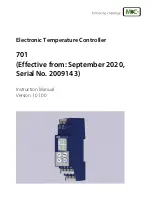
D2212B/D2212BE Operation and Installation Guide
D2212B/D2212BE
Page 25
© 2002 Bosch Security Systems
39934E
On-Board Points
6.0
On-Board Points
6.1
Point 1 (1+ and 1-)
Point 1 on the D2212 is a powered, supervised point.
The panel monitors the Point 1 sensor loop for normal, shorted, or open conditions. Programming determines how the
panel responds to those conditions. See the D2000 Series Program Entry Guide (P/N: 35114).
1+ provides positive voltage to two-wire detection devices. 1-, the loop return (-), is isolated from earth ground.
The Keypad Reset function interrupts power to this sensor loop to reset smoke detectors.
Use a 2 k
Ω
EOL resistor for Point 1. See Figure 12 on page 26 for point wiring.
Connecting Two-wire Smoke Detectors to Point 1:
Connect up to fifteen Bosch Security Systems D262 two-wire smoke
detectors to Point 1. Refer to the D2000 Series Control/Communicator Technogram (P/N: 35112), for a complete list of
detectors compatible with the D2212. Do not mix compatible two-wire smoke detector types on this loop.
Four-wire Smoke Detectors:
Connect any number (limited by available power and the Authority Having Jurisdiction) of
twelve VDC four-wire smoke detectors to any supervised point. Install a suitable power supervision device according to the
manufacturer’s instructions. Route the power for the detectors through a D133 (or D134) Relay Module. The relay module
must be connected to one of the panel’s external relay outputs programmed for the reset function. See RELAYS in the D2000
Program Entry Guide (P/N: 35114) for programming instructions.
Heat Detectors and Other Dry Contact Initiating Devices:
Connect any number (limited by the Authority Having
Jurisdiction).
Burglary Devices:
Connect any number (limited by available power) of burglary devices to any point. Do not combine fire
detection and burglary devices on the same point.
6.2
Points 2 through 6
Points 2 to 6 are supervised, non-powered points.
The panel monitors sensor loops for normal, shorted, or open conditions. Programming for each point determines how the
panel responds to those conditions. See the D2000 Series Program Entry Guide (P/N: 35114).
Terminate each sensor loop with a 1.0 k
Ω
EOL resistor. See Figure 12 on page 26 for point wiring.
Four-wire Smoke Detectors:
Connect any number (limited by available power and the Authority Having Jurisdiction) of
twelve VDC four-wire smoke detectors to any supervised point. Install a suitable power supervision device according to the
manufacturer’s instructions. Route the power for the detectors through a D133 (or D134) Relay Module. The relay module
must be connected to one of the panel’s external relay outputs programmed for the reset function. See RELAYS in the D2000
Series Program Entry Guide (P/N: 35114) for programming instructions.
Heat Detectors and Other Dry Contact Initiating Devices:
Connect any number (limited by the Authority Having
Jurisdiction).
Burglary Devices:
Connect any number (limited by available power) of burglary devices to any point. Do not combine fire
detection and burglary devices on the same point. For UL installations, wire a sounding device (such as a buzzer) to one of
the external relays (terminals Ext1 and Ext2) and to teAlrm (Alarm Output). See Figure 12 on page 26. Program the
relay for Function 3 to provide annunciation of troubles for all fire points (see RELAYS Group in the D2000 Series Program
Entry Guide [P/N: 35114]).
6.3
Points 7 and 8
Points 7 and 8 are non-powered points that are not supervised with an EOL resistor.
The D2212 monitors sensor loops for Points 7 and 8 for normal (closed) and open conditions. Programming determines
how the panel responds to these conditions. See the D2000 Series Program Entry Guide (P/N: 35114). Figure 12 shows point
wiring.
For UL systems, Points 7 and 8 can only be used for tamper contacts.
Tamper contacts must be installed within the protected
enclosure.
















































